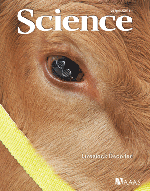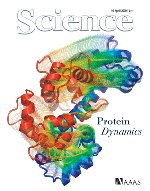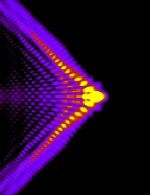 Barnyard Genomics
Barnyard Genomics
Domesticated livestock have been key to the development of human
societies and have helped guide our understanding of evolution and
biology. In the 24 Apr 2009 Science,
a collection of papers offered new insights -- afforded by genomic
analyses and molecular phylogenetic techniques -- into the biogeography
of domestication, the development of modern breeds, and the genes
responsible for agriculturally important traits. The
Bovine Genome Sequencing and Analysis Consortium and colleagues
reported on the sequence of the cattle genome, which contains a minimum
of 22,000 genes, about 14,345 of which have counterparts in seven other
mammalian species. The team notes that over the course of evolution and
domestication, changes in the number and organization of genes have
altered the biological systems of cattle, most notably affecting their
reproduction, immunity, lactation, and digestion. The
Bovine HapMap Consortium meanwhile investigated genetic variation
in geographically and biologically diverse cattle breeds, which reveals
that cattle have undergone a rapid recent decrease in effective
population size from a very large ancestral population, possibly due to
bottlenecks associated with domestication, selection, and breed
formation. Chessa
et al. used endogenous retroviruses as genetic markers to trace the
history of sheep domestication. Their analysis indicates that sheep
dispersed across Eurasia and Africa in two distinct waves and that the
later migratory episode, involving sheep with improved production
traits most likely from Southwest Asia, shaped the great majority of
present-day breeds. Finally, Ludwig
et al. examined the variation in coat-color genes in fossil horses
to shed light on the timing and place of horse domestication. They
report a rapid and substantial increase in the number of coat
colorations in horses from both Siberia and East Europe during and
after the Bronze Age, which coincides with a recent estimate of the
beginning of horse domestication. H. A. Lewin discussed the importance
of livestock genomics in a related Perspective
and podcast
interview.
Synapses and Sleep
Sleep is a biological process that is necessary for cognition and for
survival, yet the precise functions of sleep remain unknown. Now, two
fruit fly studies reported in the 3 Apr 2009 Science offer evidence to support
the so-called synaptic homeostasis hypothesis, which posits that sleep
is important for renormalizing synapses after neural activity during
waking hours. An increase in synaptic strength by the end of a waking
day would result in higher energy consumption and larger synapses that
take up precious brain space. Downscaling synaptic connections during
sleep may therefore help conserve space and energy in the brain, which
would in turn improve the capacity for learning and memory. Gilestro
et al. reported that depriving flies of sleep resulted in higher
levels of several synaptic proteins throughout the brain, and that
these protein levels declined after the flies were allowed to sleep --
independent of the time of day. In the second study, Donlea
et al. found that a specific subset of neurons involved in
circadian rhythms are required for increased sleep after social
experience and for consolidation of memories. The team also found that
the same social experiences that increased the need for sleep also
increased the number of synapses between lateral ventral neurons and
their partners in the brainstem. Moreover, the number of synaptic
terminals was reduced during sleep, and that decline was prevented by
sleep deprivation. An accompanying News
story by G. Miller highlighted the Reports.
Healing Heart
Damage to the heart through aging or disease often leads to chronic
heart failure due to loss and insufficient regeneration of heart muscle
cells (cardiomyocytes). Absence of regeneration in the heart has been
attributed to the inability of muscle cells to divide, coupled with the
absence of a muscle-producing stem cell population. Now, a Report in
the 3 Apr 2009 Science
provides strong evidence that some cardiomyocyte renewal can occur. To
determine the ages of human heart cells, Bergmann
et al. used a clever system based on radiocarbon dating of DNA.
Nuclear bomb tests during the Cold War released high concentrations of
carbon-14 into the atmosphere until the tests were banned in 1963.
Since atmospheric carbon is taken up by plant cells through
photosynthesis and subsequently by human cells and their DNA (because
humans eat plants and other animals that eat plants), the C-14
concentration in human cells formed in different years mirrors
differing atmospheric C-14 levels. By comparing the age of
cardiomyocyte DNA to the patient's chronological age, one can estimate
the extent to which the cardiomyocyte population has turned over
(senior author J. Frisén discussed the technique in a related podcast
interview). Using this approach, the team found that cardiomyocytes
do renew, albeit slowly, at a rate of 1% per year at age 25, declining
to 0.45% at age 75. This means that fewer than 50% of heart muscle
cells are exchanged during a normal life span. An accompanying Perspective
by C. E. Murray and R. T. Lee noted that "even though cardiomyocyte
turnover rate is low in the adult heart, the fact that is occurs at all
suggests that it can potentially be therapeutically exploited."
 Proteins in Motion
Proteins in Motion
Special Online Collection
Cellular proteins are in constant motion, sampling an ensemble of
different conformations and often changing interaction partners as they
play their part in a particular biological process. A special section
of the 10 Apr 2009 Science
highlighted advances in our understanding of these complex dynamics.
Review and Perspective articles explored how the dynamic properties of
proteins enable them to mediate complex signaling tasks, the
evolutionary adaptability of proteins, how cell-cell and cell-matrix
protein interactions contribute to tissue formation and homeostasis,
and the use of nuclear magnetic resonance spectroscopy in drug
discovery and design. A companion issue of Science Signaling published on 14
Apr looked at how changes in the conformation, binding partners, or
localization of signaling proteins affect the flow of information
through signaling cascades. Articles and a presentation highlighted the
mechanisms by which subcellular protein trafficking can influence
cellular behavior, conformational changes in G protein–coupled receptor
signaling, how pathogens exploit host protein interactions to their
advantage, and allosteric regulation in immune cell signaling.
Transitioning to Land
The emergence of four-legged creatures and the colonization of land by
vertebrates were key events in evolution. Research on the
fish-to-tetrapod transition has largely looked at anatomical changes
across the evolutionary tree, but a new study now describes telling
transformations within the life histories of individual species. Callier
et al. compared the humeri (upper arm bones) of the early tetrapods
Icthyostega and Acanthostega, assumed to belong to
individuals at different growth stages. While the growth of the humerus
of Acanthostega shows no
indication of a major functional change during life, that of Ichthyostega shows marked
differences between juvenile and adult individuals, with the pattern of
muscle attachment processes on small humeri resembling that in more
fish-like relatives and larger humeri showing a pattern more consistent
with other tetrapods. This suggests that Ichthyostega had a more pronounced
aquatic lifestyle when young than when adult. Moreover, this result is
at odds with character analyses for early tetrapods, which show Acanthostega as the most aquatic
tetrapod known from complete skeletons. Thus, Ichthyostega may occupy a deeper
position in the evolutionary tree than the more aquatic and seemingly
more fishlike Acanthostega.
An accompanying Perspective
by M. Friedman highlighted the Report.
 Flight Plans
Flight Plans
To fly with precision, flying animals need to be able to maneuver and
stabilize their course and orientation immediately following a change
of direction. How animals actually achieve this agility however, has
been poorly understood. In a Report in the 10 Apr 2009 Science, Hedrick
et al. combined morphology and flapping motion in a model that
predicts turn dynamics for flying animals ranging in size from fruit
flies to cockatoos. The researchers studied low-speed turns called yaw
turns in a variety of winged animals including insects, bats, and
birds, and found that these maneuvers are accomplished not by
asymmetrical wing movements, but rather by damping of the animals'
angular velocity through a passive mechanism the team terms flapping
counter-torque (listen to the related podcast
interview with corresponding authors Ty. Hedrick and X. Deng). When
a flying animal turns, the overall rotation of its body coupled with
symmetric flapping wing motion cause the outside wing to move faster
than the inside wing relative to air. The outer wing thus generates
greater aerodynamic force, and a net counter-torque that can slow the
animal's rotation. The team's model shows that geometrically similar
animals have similar turning dynamics in "wingbeat time" regardless of
size; fruit flies and hummingbirds, for example, both require the same
number of wingbeats to finish a turn. An accompanying Perspective
by B. W. Tobalske noted that the new results "will inform all future
research into maneuvering flight in animals and biomimetic flying
robots."
Subglacial Microbes
At Antarctica ’s Blood Falls, iron-rich subglacial waters flow from the
snout of the Taylor Glacier, staining the ice with rust upon contact
with air. In the 17 Apr 2009 Science,
Mikucki
et al. reported that the source of this rusty outflow is a pocket
of ancient seawater that was trapped some 1.5 to 4 million years ago
under the advancing glacier. The water is anoxic, highly ferrous and
saline, contains sulfate, and supports a metabolically active microbial
community. Isotopic measurements of sulfate, water, carbonate, and
ferrous iron, combined with genetic analysis, indicates that reduction
of sulfate to sulfite is occurring by microbially coupled sulfur and
iron cycles driven by the enzyme adenosine 5′-phosphosulfate reductase.
These coupled biogeochemical processes explain how a microbial system
can grow in extended isolation without photosynthesis or nutrients from
an external source. A related ScienceNOW story by J. Grom
noted that "[t]he findings provide insight into how life may have
survived 'Snowball Earth' periods when some scientists speculate that
the planet was entombed in ice -- and hint at the possibility of life
in other inhospitable environments, such as Mars and Jupiter's icy moon
Europa."
 Automating Science
Automating Science
Computers are playing an ever-greater role in the scientific process
and contributing to a vast expansion in the production of scientific
data. Designing robots that can close the loop from experimental design
and data collection to hypothesis formation and revision, and from
there to new experiments, will be one important way to cope with the
growing volume of data. Two Reports in the 3 Apr 2009 Science described efforts that push
the boundaries of automatic scientific experimentation and discovery in
this direction. King et
al. developed a robot scientist, "Adam," that could autonomously
formulate hypotheses about the origins of yeast orphan enzymes --
enzymes for which scientists have been unable to identify the encoding
genes. The robot then planned and executed experiments to test its
hypotheses--selecting yeast mutants from a collection, incubating
cells, and measuring their growth rates, and identified several enzymes
that were confirmed (by humans) to function in yeast metabolism. Schmidt
and Lipson developed an algorithm to search for natural laws of
physics in large data sets without any prior knowledge about physics,
kinematics, or geometry. Given raw data on the behavior of physical
system like a pendulum, the algorithm searched the gamut of possible
mathematical equations consistent with the data and converged on
fundamental laws of motion. An accompanying Perspective
by D. Waltz and B. G. Buchanan, as well as a related podcast
interview, discussed the benefits of using intelligent automated
systems as assistants for the foreseeable future.
Stronger Silk
In nature, tiny amounts of inorganic impurities, such as metals, can be
incorporated into the protein structures of biomaterials, leading to
enhanced mechanical properties -- particularly stiffness and hardness.
Zinc, manganese, and copper, for example, have been identified in
insects' protective chitin cuticles as well as their tough mandibles,
stingers, and claws. In a report in the 24 Apr 2009 Science, Lee et
al. showed that metal-enhanced biomaterials can be made in the
laboratory. Using a technique called multiple pulsed vapor-phase
infiltration, the team showed that zinc, titanium, and aluminum can be
inserted in fibers of spider silk and improve the silk's already high
tensile strength. In addition to forming a coating on the fibers, some
of the metal ions penetrate the fibers and react with the protein
structure. The doped fibers showed a significant increase in toughness
as measured by the work required to break or deform them. The technique
may be useful for manufacturing super-tough textiles or more durable
surgical thread, and could serve as a model for a more general approach
to enhance the strength and toughness of other biomaterials.
 Curving Laser Beams
Curving Laser Beams
Laser beams are typically thought of as monochromatic, coherent, and
directional (traveling in a straight line). However, the advent of
laser sources that emit ultrashort laser pulses has changed this simple
picture. These sources are broadband, may maintain coherence for only
very short times, and are so intense that, when traveling through a
medium such as air, they can create self-focused blasts of plasma or
"light bullets." As one would expect from light, these plasmas follow
straight trajectories. Now, in a Report in the 10 Apr 2009 Science, Polynkin
et al. show that complex energy flows within high-intensity laser
beams can cause them to curve as they travel. Using asymmetrical light
beams called Airy beams, the researchers showed that the nonlinear
optical effects at high intensities can generate plasma filaments that
split from the main plasma channel, effectively sending the light
bullets around bends on mathematically predictable trajectories.
Possible applications of this technology include remote sensing, or the
diversion of lightning strikes from sensitive targets such as airports.
An accompanying Perspective
by J. Kasparian and J.-P. Wolf highlighted these and other potential
applications.
Boundary Refinement
Plate tectonic theory hinges on the concept of a rigid lithosphere,
formed at mid-ocean ridges, floating above a weaker, more deformable
asthenosphere -- but the depth of nature of the
lithosphere-asthenosphere boundary (LAB) remain poorly understood. Two
Reports in the 24 Apr 2009 Science
described seismic studies that help refine the LAB and hence the
thickness of the lithosphere and of tectonic plates. Kawakatsu
et al. analyzed data from broadband ocean bottom seismometers,
which show that the LAB beneath the Pacific and Philippine Sea plates
is sharp and that oceanic plate thickness deepens with age. The data
also imply that the asthenosphere is partially molten and consists of
horizontal melt-rich layers embedded in meltless mantle. Rychert
and Shearer used 15 years of seismic data to explore the global
distribution of an anomaly imaged by conversion of pressure waves to
shear waves (waves associated with a sharp velocity drop). They
consistently detected a sharp negative gradient that may correspond to
the LAB at a depth that varies from about 70 kilometers beneath ocean
islands to about 95 kilometers beneath Precambrian shields and
continental cratons, the oldest, most stable parts of the continental
crust. An accompanying Perspective
by B. Romanowicz highlighted the studies and noted some of the
challenges of distinguishing the seismic signature of the LAB from
other structures within the lithosphere.
In Science Signaling
Focus on mTOR
On 21 Apr 2009, Science Signaling
published a focus issue on the mammalian target of rapamycin (mTOR), a
master integrator of cell energy state, nutrient status, and growth
factor stimulation. A Perspective
by Janes and Fruman discussed the effects of the mTOR inhibitor
rapamycin on the immune system, and a Perspective
by Vogt and Hart addressed mTOR signaling in the context of
glioblastoma. Guertin
and Sabatini reviewed pharmacological inhibitors of mTOR signaling
and their potential clinical uses, and Alessi
et al. considered recent findings about the biochemistry of
signaling through the mTORC2 complex. An Editorial
Guide by N. Gough and a podcast
featuring Science Signaling
Chief Scientific Editor Michael Yaffe provided overviews.
Also in Science Signaling
this month:
-- Irrcher
and Park discussed the role of autophagy in Parkinson's disease (7
April 2009)
-- Pouille
et al. reported that mechanical forces promote signaling during
mesoderm gastrulation in the fly (14 April 2009)
-- Mustafa
et al. reviewed the mechanisms through which gaseous messenger
molecules act (28 April 2009)
-- Coba
et al. described the complex effects of neurotransmitter
stimulation on the phospohorylation status of postsynaptic proteins (28
April 2009)
Image credits (in order of appearance): *Science* cover, 24 April 2009;
*Science* cover, 10 April 2009; Jose Iriarte-Diaz; Jen Rowland;
*Science*/AAAS.





